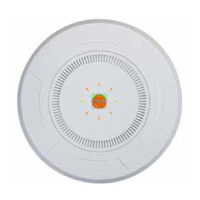Wireless Access Point
328 Configuring the Wireless AP
24. MDNS Filter: There are many different types of services that may be
specified in multicast query and response packets. The mDNS filters let
you restrict forwarding, so that multicast packets are forwarded only for
the services that you explicitly specify. This list may be used to restrict the
amount of Apple Bonjour multicast traffic forwarding. For example, you
may restrict forwarding to just AppleTV and printing services. Please see
the description of multicast forwarding in Step 22 above.
The MDNS Filter operates as follows:
• If you leave this field blank, then there is no filter, and mDNS
packets for all service types are passed.
• If you enter service types, then this acts as an allow filter, and
mDNS packets are passed only for the listed service types.
To add an mDNS packet type to the list of packets that may be forwarded,
select it from the drop-down list in the top field and click the Add button
to its right. The drop-down list offers packet types such as AirTunes,
Note that Multicast Forwarding and mDNS Filtering capabilities also work
if both devices are wireless. For example, let’s say that AppleTV is using
wireless to connect to an SSID that is associated with VLAN 56, and the
wireless client is on an SSID that is associated with VLAN 58. Normally the
wireless client would not be able to use Bonjour to discover the AppleTV
because they are on separate VLANs. But if you add 224.0.0.251 to the
Multicast Forwarding Addresses, then add VLANs 56 and 58 to the
Multicast VLAN Forwarding list, then the wireless client will be able to
discover the AppleTV. In this same scenario you could add AppleTV to the
MDNS Filter list so that only MDNS packets for the AppleTV service type
would be forwarded between VLANs 56 and 58.
Note that all the VLANs that you add to this list do not have to be associated
with SSIDs. As an example, say that AppleTV is on the wired network on
VLAN 56, while the wireless device is connected to an SSID that is
associated to VLAN 58. In this case, VLAN 56 and 58 need to be defined on
the AP but only VLAN 58 needs to be associated to a SSID.

